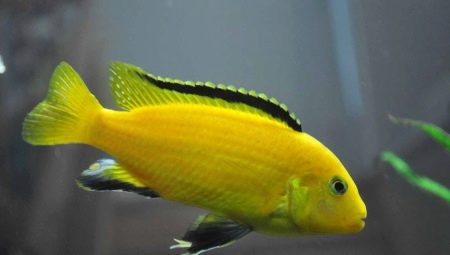Many aquarists are not averse to decorating their tank with an inhabitant such as labidochromis yellow. This bright fish will be a real accent among all your pets. However, before starting it, it is worth familiarizing yourself with the features of her body, the habitat that is familiar to her. It is also important to take into account the compatibility of these individuals with other species of fish, the rules for their maintenance and the nuances of reproduction. All these aspects will be discussed in detail in this article.

Description
Labidochromeis yellow, also called hummingbird, belongs to the order of cichlids and the family of cichlids. This fish is distinguished by its bright yellow color, which occupies almost its entire body. The body length of aquarium individuals is 8 cm, while in the natural environment it can reach 10 cm. The body is elongated in shape, and the silhouette of the dorsal fin is pointed. This part of the fish’s body also includes a dark strip along its entire length, the color intensity of which varies among fish of different sexes. Subject to the necessary conditions, such a fish can survive up to 10 years, but on average their life is 7–8 years.

Living in nature
A typical habitat for labidochromeis yellow is the African lake of Malawi. They live in the coastal zones of the western part of this reservoir, which is located along the rocky coastlines. Wild individuals do not live very far from the surface of the water - at a distance of 10 to 50 m.It is noteworthy that among them a rather small amount is precisely the yellow color, the main colors are blue or white. These fish live in pairs or alone. Labidochromeis refers to such a type of cichlids as mbuna, whose name translates as “attacking rocks”. These fish feed on plants growing on stones near rocky shores. Despite the close habitat to the surface, in nature these species are difficult to observe because they like to hide between stones, in small caves and crevices of rocks.
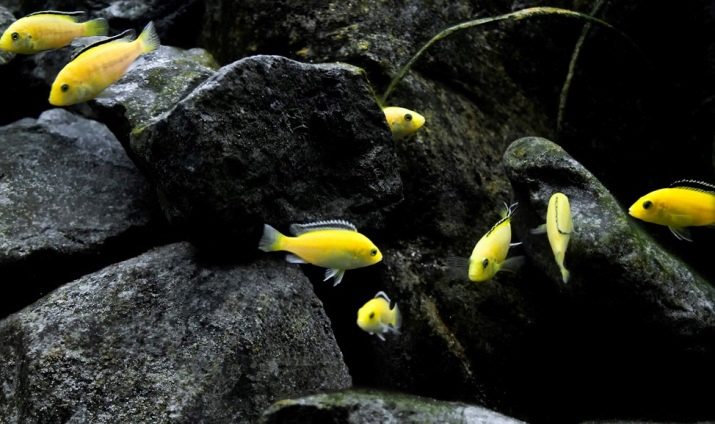
Gender differences
To distinguish the male lobidochromeis yellow from the female, you need to pay attention to the color features of the individuals. Males are characterized by a brighter yellow color, as well as a strip on the dorsal fin, painted in a more saturated black color than in females. The same intense tone is characteristic of the male ventral and anal fins. Moreover, in females, these two fins are colored yellow.
The difference between the male is also the presence of dark spots in the area between the eyes or near the oral cavity. The transition from the dorsal to the head is smoother in females, and in males the angle of this transition is usually quite steep, and can even form a depression closer to the mouth. Size is also a criterion for the sex difference of these fish. Males are larger than females.

Compatibility
Belonging to the class of cichlids, these fish are distinguished by their peace-loving character, with the exception of spawning periods when lobidochromes yellow can be aggressive. The best neighbors in the general aquarium will be other varieties of African cichlids that are similar in size to lobidochrome. These fish include the following:
- blue dolphin;
- lamprologus;
- pseudotrophaeus aki
- ancistrus;
- aulonocar;
- corridor;
- cynotilapia afra;
- thoracicum.
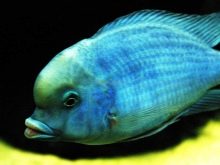

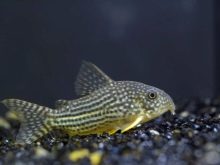
It is worth considering that it is undesirable to place lobidochromeis yellow with other fish from the order of cichlids that belong to another continent.
The difference in habitats affects both food requirements and the conditions of keeping these fish. Avoid settling other yellow individuals to lobidochromis, as hummingbirds can be aggressive, taking these creatures for males of their own species. Neighboring fish should not have such qualities as sluggishness, predatory habits, as well as too small a size. Examples of unsuccessful options are the following fish:
- tetra;
- gold fish;
- zebrafish
- neon;
- parrot fish;
- astronaut.
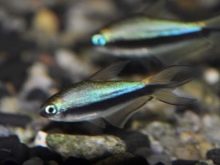
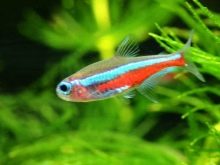
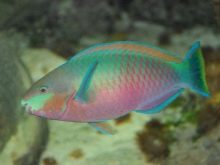
Growing conditions
When planning the maintenance of fish species such as lobidochromeis yellow, It is worth paying attention to the following nuances that relate to the maintenance of the aquarium and maintenance:
- the temperature of the water in the tank can vary from +24 to +28 degrees Celsius;
- acidity should be in the range of 7.2 to 8.8, while hardness is 10–20 dH units;
- 100 liters - the minimum volume of the tank, suitable for accommodating no more than 4 fish; ideally, if the capacity is 200-300 l, which allows you to have a greater number of individuals of hummingbird labidochromechis and more fully reveal their lifestyle and habits for observation;
- the decor in the tank should correspond to the environment inherent in the natural habitat of these fish, stones and grottoes, recreation of gorge landscapes will be not superfluous; for the beauty of the atmosphere in the aquarium, you can add driftwood of grapes or mangroves there, even such an element of decor as a coconut shell is allowed;
- from plants for the design of the aquarium with these yellow fish, anubias and cryptocorynes will be most suitable, because these representatives of the flora are unpretentious, besides, the fish will not touch them; note that the plants must have a developed root system and be firmly rooted in the ground, since lobidochromeis yellow can undermine the soil near the plants;
- as the soil for these individuals, it is better to choose river sand, coral or marble chips, as well as shell rock;
- so that the fish tolerate the change of water in the tank well, it is better to add new water in small portions.

When choosing additional lighting for an aquarium with this yellow fish, remember that it is most pleasant to the blue spectrum; to improve the color of individuals, you can add yellow or green shades to the lighting.
Proper feeding
Yellow lobidochromes are classified as omnivores. They are not picky about food and eat food of any kind, whether dry or frozen, or live. If you want live feeding, which can be used as a tubule, bloodworm, does not harm the pets, you should not feed them in too much quantity (due to their rich protein content), as well as pre-treating it with a few drops of iodinol. A homemade type frozen food would also be a good option. Plant foods are also beneficial. Of these, pay attention to spinach, lettuce, spirulina granules. The first two products must be scalded before feeding.
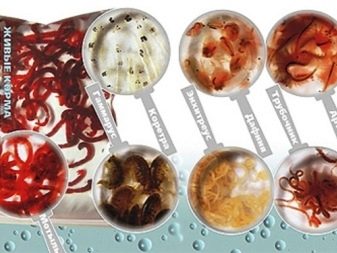

When choosing dry food, give preference to those options that have sealed packaging and the current shelf life. Also, read the reviews before you buy. There are such types of food that are created specifically for fish at different periods of their development, and are additionally enriched with a vitamin complex. The main thing is that the diet of lobidochromeis yellow is not monotonous. Feed the fish several times a day in not very large portions and remove leftover food from the tank in a timely manner. In addition to the above options, other products in the menu of this type may be the following:
- mussels;
- duckweed;
- Cyclops;
- cereals;
- shrimp
- carrots, peas, pre-peeled;
- meat in the form of minced meat;
- Artemia
- daphnia.

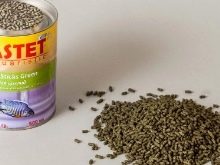
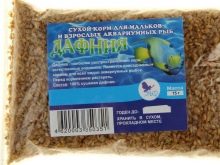
Breeding
The process of breeding yellow lobidochrome is not very difficult and can occur in an aquarium even without human intervention. This is due to the fact that the survival rate of fry is very high. However, it is possible, as an option, to transplant the male and female into a special spawning tank, where subsequently there will be newborn fish. To stimulate the beginning of the spawning period, you should increase the temperature in the tank by several degrees. When the male and the female form a pair (which, incidentally, is usually very stable), they will create a depression in the ground, into which eggs will later be laid.
Important! The age of the fish affects the amount of caviar: in young individuals it is then 8 to 10 pieces, while in adult fish it reaches 30 pieces.
Further, the incubation period begins, during which the female places the eggs in the oral cavity and carries it there for about three weeks. After this period, fry are born. During the first week, the female actively takes care of her offspring, but later the young fish become left to their own devices. From the side of the breeder it is important to take care of the appropriate feeding of young individuals. Their diet may include components such as cyclops, live dust, brine shrimp, as well as feed for adult fish in a crushed state.
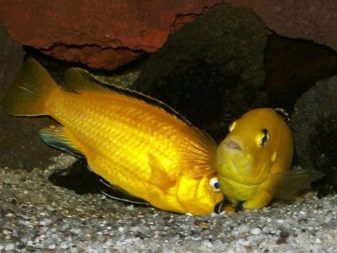
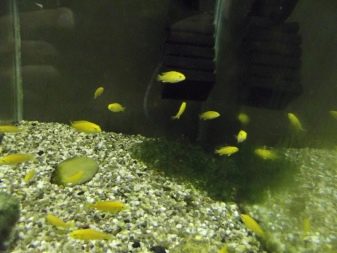
Diseases
To ensure that the life of hummingbird lobidochromes is as comfortable as possible, it is important not only to comply with the conditions of detention, but also to know in advance about the diseases of this fish and their possible causes. It is worth considering the ailments that may appear in these yellow individuals.
- Bloating in Malawi is one of the most serious diseases requiring emergency treatment. It can be caused by factors such as poor nutrition or neighborhood, as well as the mismatch of conditions in the aquarium with the necessary parameters. The cure for this disease is usually antibiotics of strong action.
- Tuberculosis can develop in these aquarium inhabitants if an already infected individual is planted with them. To prevent this serious illness from spreading, isolate sick fish in a separate container and add vitamin B6 to the water as a solution.
- If the fish began to lose coordination and mobility, it is possible that poisoning with toxic substances such as chlorine or ammonia occurred. To prevent this from happening, keep an eye on the aquarium's filtering and conditioning system; do not treat plants and decor with chemicals.
- Inhabitants of the aquarium can get injured due to conflicts with each other or if the decorative elements have too complex handicaps or sharp edges. Provided that the immunity of the fish is functioning normally, such ailments occur naturally.
- Dangerous is fin rot disease. First, the fin processes are covered with a white coating, as well as red stripes, which leads to the destruction of the fins.
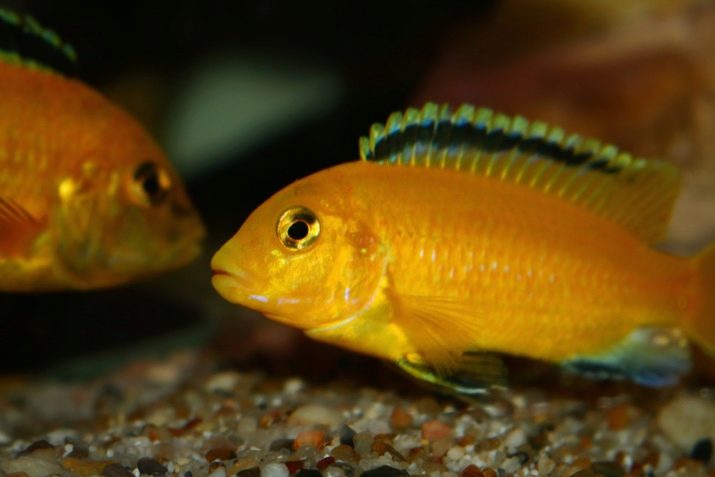
To cure such an ailment, you need to use antibiotics.
For breeding, spawning and keeping Labidochromeis Yellow in the aquarium, see the next video.
